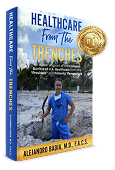MIAMI, Sept. 20, 2021 /PRNewswire via COMTEX/ — MIAMI, Sept. 20, 2021 /PRNewswire-PRWeb
– That self-diagnosed “only a wrist sprain” could well prove to be an injury in need of surgical repair, according to Miami-based orthopedist Alejandro Badia, who says ligament and cartilage damage or fractures of one or more of the wrist’s small bones are oftentimes an underlying cause of joint pain and stiffness, especially after a fall or other trauma.
“Ligament and cartilage lesions and severe joint fractures are types of problems frequently requiring minimally invasive arthroscopic surgery by an experienced orthopedic specialist,” says Dr. Badia, who is noted for treatment of upper-limb joint disorders.
“Patients with persistent wrist pain should contact an orthopedic surgical specialist immediately. Delays in care may result in further wrist damage and ultimately affect a patient’s quality of life.
Assuming ‘it’s just a sprain’ or seeking help from primary care or emergency medicine physicians who have no expertise treating musculoskeletal disorders could prove costly and hinder a patient’s eventual recovery and return of wrist strength and mobility.”
Arthroscopic surgery is so named for a surgeon’s use of an arthroscope, a tiny camera that can be inserted into the joint or other area of the body to aid visual examination and diagnosis and ensure pinpoint surgical correction of any disease.
The camera provides 3-D images that are projected onto a monitor for the surgeon to view. When performing arthroscopic surgery, the specialist cuts several incisions of less than a half inch through which he can manipulate micro-instruments.
Advantages of this kind of minimally invasive surgery include less postoperative pain, quicker recovery, and reduced risk of infection, Dr. Badia says.
“The arthroscope can be used in combination with open surgery for repair of serious bone fractures extending into the wrist joint. However, the majority of patients with wrist joint pain have sustained a subtle cartilage or ligament tear, which many times can only be clearly detected with an arthroscope.
That makes the scope both an important diagnostic and therapeutic tool in the treatment of these joint injuries,” says Dr. Badia, a sports medicine expert and the founder and chief medical officer of the Badia Hand to Shoulder Center and OrthoNOW®.
He adds that an arthroscopic approach is most useful in removal of cartilage or other joint tissue that has loosened or become diseased due to trauma and the mending of tears in ligaments and cartilage, particularly in the triangular fibrocartilage complex (TFCC).
The TFCC is located in the wrist between the forearm’s two long bones – the radius and the ulna – and is what stabilizes the forearm bones and controls wrist and forearm motion when rotating the arm or using the hand to grasp something, Dr. Badia explains.
He cites recent studies — one just published in the June 2021 Journal of Hand Surgery – reporting on “revolutionary” advances in arthroscopic wrist surgery, with emphasis on new techniques for ligament reconstruction, repair of the TFCC, and bone grafting when a wrist fracture, including the scaphoid bone, fails to heal. The scaphoid, one of the wrist’s small carpal bones, frequently cracks in a fall.
Another recent arthroscopic technique – arthroscopic thermal annealing, a process involving application of heat – is proving effective as a treatment for instability of the wrist joint at a notch between the forearm’s distal radius and ulna bones, according to research published in 2021 in the Journal of Wrist Surgery.
Dr. Badia points to falls, in both sports and everyday activities, as a leading cause of wrist damage. In fact, statistics show that, across all age groups, the upper limbs are generally more susceptible to injury in a fall.

“Wrists frequently take the worst of the impact because persons instinctively extend their arms and hands out to brace themselves in an effort to break their fall,” he says. “Severity of injury depends on the force of the blow to the wrist joint and the extent to which the wrist is bent backwards.”
Of much concern to Dr. Badia and other orthopedic specialists is physician overuse of magnetic resonance imaging (MRI) to diagnose wrist pain.
“Oftentimes, MRI scans fail to show the pathology causing the problem. That’s because the tear affects the joint interval only when the patient’s joint is in motion – something not seen on MRI images,” Dr. Badia advises. “A negative MRI does not necessarily mean the patient has no treatable problem.
In fact, a negative scan can cause difficulties in a patient obtaining needed financial coverage for correction of what is later determined to be a real injury. Insurance companies have far too much control of the treatment process in this country.”
Meanwhile, “plain x-rays can tell us if a patient has incurred a wrist fracture, although such fractures rarely require arthroscopy,” Dr. Badia says
Dr. Badia describes the wrist as an “engineering marvel whose motion is critical to the ability of the hand and fingers to grab, grasp, twist, and pick up objects.”
The joint is actually a complex of several small joints consisting of eight irregularly shaped bones. These bones are joined by ligaments and tendons, with cartilage at the ends of bones providing the “oil” that allows them to glide around each other.
The importance of the wrist joint cannot be understated,” Dr. Badia says. “It engages in a wide range of movements required for everyday activities like simply tying a shoe or buttoning a shirt.” He offers the following tips to protect the wrists:
• Consider wrist-strengthening activities. For example, experts recommend extending a towel out in front of you with both arms and then wringing it out for about 20 seconds as if trying to remove excess water from it and then repeating this activity four or five times. Also occasionally exercise the wrist joints by rotating them in a circular pattern, especially when using them to type on a keyboard for prolonged periods of time.
• Introduce simple wrist exercises to a warm-up routine before engaging in sports, particularly those involving repetitive wrist motion like tennis and golf.
• Avoid sleeping positions that bend or curl the wrists.
• Practice good posture when seated and adjust your chair or tabletop so that the wrists do not bend upwards or downwards when working at the computer and, if wrist pain develops and persists, call an orthopedic surgeon – today,” Dr. Badia advises.







